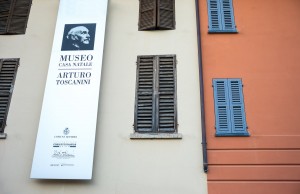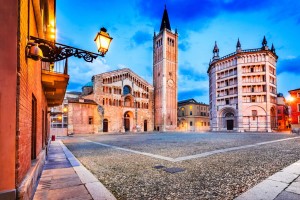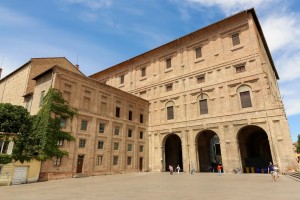
©Bigstock.com/Gimas
When it comes to Parma you will probably first think of the amazing, multifaceted, rich cuisine of the city and the entire province. Parmesan and Parma ham spoil the palate and are both foundation and sides to genuine culinary treats. However, there’s actually an incredibly diverse city of arts with a plethora of churches, cloisters and palaces, all of which bore witness to a highly eventful history with several small peaks, waiting for you behind these sumptuous highlights. Join us on a brief tour through the north of Emilia Romagna!
Ever-changing rulers throughout history
The city’s roots date far back into prehistoric times. There had likely been Terramare pile dwellings as early as the Bronze Age. The first necropolis was established on today’s Piazza Duomo and Piazzale della Macina. Parma itself was supposedly founded by the Etruscans, the name (meaning “round shield”) being a Latin borrowing. A Roman colony was established around 183 BC. Destroyed by Attila and later given to Odoacer’s following, Parma, like many other cities of this region, saw a plethora of different rulers during the Migration period. It would take until 1545/47 for a sharp break when People Paul III established the Duchy of Parma for his illegitimate son Pier Luigi Farnese. Renaissance painter Antonio da Correggio had already left his mark on the city by this time. We will hear from him time and time again.
The end of the male Farnese line led to another noteworthy break in the 18th century. Both the War of the Polish Succession and the War of the Austrian Succession had a decisive influence on Parma’s fate. Several abdications and failures would bestow the former duchy on Philip of Spain and eventually – with added Bourbon influence – on his son Ferdinand. Napoleon laid claim to the combined Duchy of Parma and Piacenza after the Napoleonic Wars before the Bourbon would rise to power one final time. A brief intermezzo as part of the short-lived United Provinces of Central Italy finally put an end to the frequently changing succession of rulers. Parma has been part of Italy since 1861.
Piazza Duomo

©Bigstock.com/cge2010
Parma was repeatedly expanded over the course of many centuries despite its ever-changing rulers and eventful, almost hectic history. It is now home to numerous spectacular buildings that attract guests from all over the world, and probably you as well. Your first stop is Piazza Duomo (Cathedral Square) with a collected 900 years of local, art and cultural history in one magical place. You’d love to know what exactly there is to see? Well then:
- Cathedral: A devastating fire destroyed the old Church of Our Lady. Construction of Santa Maria Assunta on the same site commenced in 1074. The Romanesque cathedral with its Gothic bell tower was built across several different construction periods and later drastically changed on the inside during the Renaissance. Correggio’s perspective cupola fresco and the Gothic frescoes in the side chapels are especially worth seeing.
- Baptistery San Giovanni: This octagonal sacred building is a genuine looker. You will see the pink façade made of Verona marble from afar. The vault of the cupola is divided into six different, fully painted levels, each dedicated to specific topics and eventually opening up to a spectacular red sky on the ceiling.
- San Giovanni Evangelista: A fire damaged the original 10th century Benedictine monastery that was in turn given a Mannerism façade. Its cupola features yet another breathtaking fresco by Correggio. Don’t sleep on the three cloisters and the monastery library either.
More churches and cloisters in Parma
Talking about churches and cloisters, why not stay in the religious area for now? Parma is home to a plethora of stunning, diverse sacral building we cannot recommend highly enough.
- San Martino de Bocci: Well, you caught us, we sort of cheated here just a little bit. For one thing, this building is located in the Paradigna district around 6 km north of the city itself. On the other hand, San Martino de Bocci is a former, abandoned Cistercian abbey. Now home to the study and archive centre of the city’s university, San Martino de Bocci continues to fascinate with its mix of original Gothic shapes and changes from later periods, particularly rococo and Empire.
- Synagogue: There had been a large Jewish community in Parma in the Middle Ages until a papal bull from the year 1555 banished the population from the combined duchy. Napoleon’s conquest finally facilitated a resettling in the region. Built in 1866, the synagogue serves as a religious centre and was palpably inspired by the Catholic churches of its time.
- San Paolo: Yes, we palm off another former monastery to you. Because we can. And, well, why not? Our main focus is the Camera della Badessa or Camera di San Paolo. During her first decade as abbess Giovanna Piacenza commissioned the decoration of one of her private rooms to – here he is again – Correggio. Unique frescoes seemingly expand toward the sky.
- Santa Maria della Steccata: A fence (“Steccato”) separates believers from the popular sanctuary – an enshrined picture of a Nursing Madonna – in this Renaissance church, hence the name. Other stunning features are the breathtaking baroque altar and Bernardino Gatti’s ceiling frescoes of the Assumption of Mary.
Even more highlights for your city tour

©Bigstock.com/Bigstock
As we are thoroughly enjoying ourselves, we carry on and expand our overview to some other personal favourites we absolutely need to introduce you to:
- Palazzo della Pilotta: Duke Ottavio Farnese had this building complex constructed during the final years of his reign. Even though later rulers brought the art treasures to Naples after the decline of the Farnese, the palace remains a genuinely exciting place with the National Archaeology Museum, the National Gallery, the baroque theatre Teatro Farnese as well as many other museums, libraries and educational facilities waiting behind its imposing gates.
- Teatro Regio: An abandoned monastery – yes, we have already had a few of those – had to give way for this opera and theatre. Commissioned by Duchess Marie Louise of Austria, the massive auditorium seats 1,400 persons and is the site of the annual Festival Verdi.
- Museum House of Toscanini: The world-famous conductor Arturo Toscanini was born in Parma on 25 March 1867. His birthplace now acts as a museum dedicated to various aspects of the life of the famous son of the city. Various objects and memorabilia from his life plus furniture from days long gone accompany your visit.
- Parco Ducale: Finally, it’s time for a bit of nature. Parma’s historic park expands an astonishing 208,700 m². Several palaces, fountains, theatres and green areas accompany your walk. You absolutely should visit the palace Palazzo del Giardino with its countless frescoes and stucco works.
The city of arts Parma guarantees tons of variety, quiet moments and, obviously, exquisite cuisine. Be enchanted by the diverse architectural masterpieces with its spectacular collections of paintings and frescoes and explore all aspects of this fascinating city in the north of Emilia Romagna. Enjoy your trip!